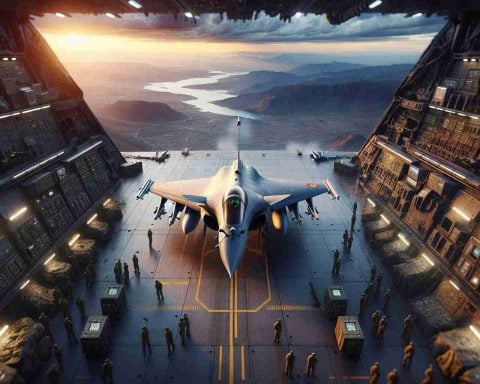Russia has initiated flight tests with a fascinating tweak to its Su-57 Felon fighter jet. Equipped with an experimental flat nozzle, the aircraft, known as “052,” is currently drawing attention and speculation from the global defense community.
The Mystery of the New Nozzle
This flat nozzle experiment was originally associated with Russia’s S-70 “Okhotnik” unmanned aerial vehicle, yet recent observations revealed the S-70 using traditional nozzles. This has raised questions over the true objective of implementing this technology on the Su-57. Analysts suggest the enhancement could focus on stealth capabilities or improve aerodynamic performance, similar to what the U.S. F-22 Raptor achieves with its innovative engine design.
Technological Evolution
Adding to the intrigue, Russia’s push for significance in fighter jet development is evident through ongoing advancements. Notably, the nation is advancing towards incorporating a new engine, the “Izdeliye 30,” for the Su-57. Although this engine promises greater stealth and agility, current operational models still use the AL-41F1/S engine, shared with the Su-35 fighter.
The Road Ahead
As global powers continuously enhance fighter jet technologies, Russia’s investment in refining the Su-57’s design is a clear indication of its aspirations on the world stage. While the exact benefits of the new nozzle remain under wraps, the development signifies an ongoing effort to push the boundaries of aircraft performance and maintain the Su-57’s status as a next-generation fighter.
Revolutionary Moves: Russia’s Su-57 Now in the Spotlight for Fighter Jet Innovators
Exploring the Future of Stealth in Aviation
Russia’s recent advancements with the Su-57 Felon have captured significant attention, especially due to the implementation of an experimental flat nozzle. This innovation potentially marks a new era in aviation stealth technology. Unlike traditional nozzles, the flat design might reduce radar cross-section, making the aircraft less detectable — a critical factor for next-generation stealth fighters. Analysts suggest that such adaptations could serve dual purposes: enhancing aerodynamic efficiency and offering improved thermal management by dispersing heat more effectively.
Comparative Analysis: Su-57 Felon versus U.S. F-22 Raptor
Such developments lead to inevitable comparisons with the U.S. F-22 Raptor, renowned for its stealth and aerodynamic efficiency. Both aircraft seem to share a trajectory in design philosophy, where flat nozzles serve not only as performance enhancers but as critical components of stealth. However, the Su-57’s path offers a unique narrative of blending innovation with existing technologies like the AL-41F1/S engine, while anticipating future enhancements with the upcoming “Izdeliye 30” engine.
Security Aspects and Implications
The introduction of the flat nozzle also poses intriguing security dynamics on a geopolitical scale. With stealth capabilities being a crucial determinant in modern aerial combat, this development could shift strategic advantages. It emphasizes the pivotal role of technological progression in national defense strategies, particularly for countries looking to establish themselves as leaders in aerospace defense innovation.
Innovations in Defense Technology Trends
This leap forward from Russia suggests an increasing focus on diversifying tactical aviation capabilities. It aligns with global trends pointing towards multi-role combat aircraft that are not only advanced in electronics but adept in maintaining a lower radar profile. The Su-57’s advancements reflect a broader industry trend of integrating multi-dimensional enhancements — from engine improvements to sophisticated avionics.
Predictions for the Aerospace Market
The aerospace sector could witness increased interest and investment in similar technologies, potentially influencing procurement strategies worldwide. As military powers prioritize stealth and efficiency, speculative ventures akin to Russia’s flat nozzle might emerge across national defense projects globally, promising a new roadmap for air combat supremacy.
For further insights into defense technology and advancements, visit TASS for comprehensive updates and analysis on globally-relevant developments.


















